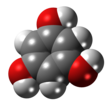Phloroglucinol
Phloroglucinol, and its benzenetriol isomers, are still defined as "phenols" according to the IUPAC official nomenclature rules of chemical compounds.Evidence for this equilibrium is provided by the formation of the oxime: But it behaves also like a benzenetriol as the three hydroxyl groups can be methylated to give 1,3,5-trimethoxybenzene.[9] Additionally, the compound can be similarly prepared from glucosides, plant extracts and resins such as quercetin, catechin and phlobaphenes.[11] The anthelmintic activity of the root of Dryopteris filix-mas has been claimed to be due to flavaspidic acid, a phloroglucinol derivative.Formylated phloroglucinol compounds (euglobals, macrocarpals and sideroxylonals) can be found in Eucalyptus species.Humulone is a bitter-tasting chemical compound found in the resin of mature hops (Humulus lupulus).[19] A 2022 phase 3 study conducted in Italy on 364 patients indicated phloroglucinol and its derivative must be as effective as nonsteroidal anti-inflammatory drugs for the treatment of pain and spasms of biliary or urinary tracts.This test relies on reaction of the furfural with phloroglucinol to produce a colored compound with high molar absorptivity.A brilliant red color develops, owing to the presence of coniferaldehyde groups in the lignin.It is also part of Gunzburg reagent, an alcoholic solution of phloroglucinol and vanillin, for the qualitative detection of free hydrochloric acid in gastric juice.
Preferred IUPAC nameCAS NumberChEMBLChemSpiderECHA InfoCardEC NumberPubChemRTECS numberCompTox DashboardSMILESChemical formulaMolar massMelting pointSolubility in waterSolubilitydiethyl etherethanolpyridineAcidityMagnetic susceptibilityATC codeA03AX12GHS labellingPictogramsHazard statementsPrecautionary statementsstandard stateorganic compoundsynthesispharmaceuticalsexplosivesbenzenetriolshydroxyquinolpyrogallolphenolspolyphenolsphloretinHeinrich HlasiwetztrinitrobenzeneanilinehydroxidehydrolysistautomersHoesch reactionLeptospermonePentacarbon dioxidepyrolysisphloretic acidflavonoidpotassium hydroxideglucosidesresinsquercetincatechinphlobaphenessecondary metabolitesDryopteris argutaDryopteris crassirhizomaDryopteris filix-masflavaspidic acidFormylatedEucalyptusHyperforinadhyperforinSt John's wortHumuloneisoprenoidHumulus lupulusBrown algaeEcklonia stoloniferaEisenia bicyclisZonariaphlorotanninsPseudomonas fluorescensphloroglucinol carboxylic aciddiacetylphloroglucinoltype III polyketide synthasemalonyl-CoAspyrogallol hydroxytransferase1,2,3,5-tetrahydroxybenzene1,2,3-trihydroxybenzenePelobacter acidigalliciphloroglucinol reductasedihydrophloroglucinolEubacterium oxidoreducensBradyrhizobium japonicumresorcinolPhloretin hydrolasephloretategallstonesspasmodic painobstetricgynecologicalnonsteroidal anti-inflammatory drugsfatty acid synthaseATC code A03diazo dyesFlopropione1,3,5-trinitrobenzenecondensed tanninsdepolymerisationnucleophileTollenspentosesfurfuralligninconiferaldehydetolonium chlorideGunzburg reagentvanillinBibcodeWayback Machinefunctional gastrointestinal disordersfunctional bowel disordersAntimuscarinicsCamylofinDicycloverineDifemerineDihexyverineMebeverineOxyphencycliminePiperidolateRociverineTrimebutineQuaternary ammoniumBenzilone



